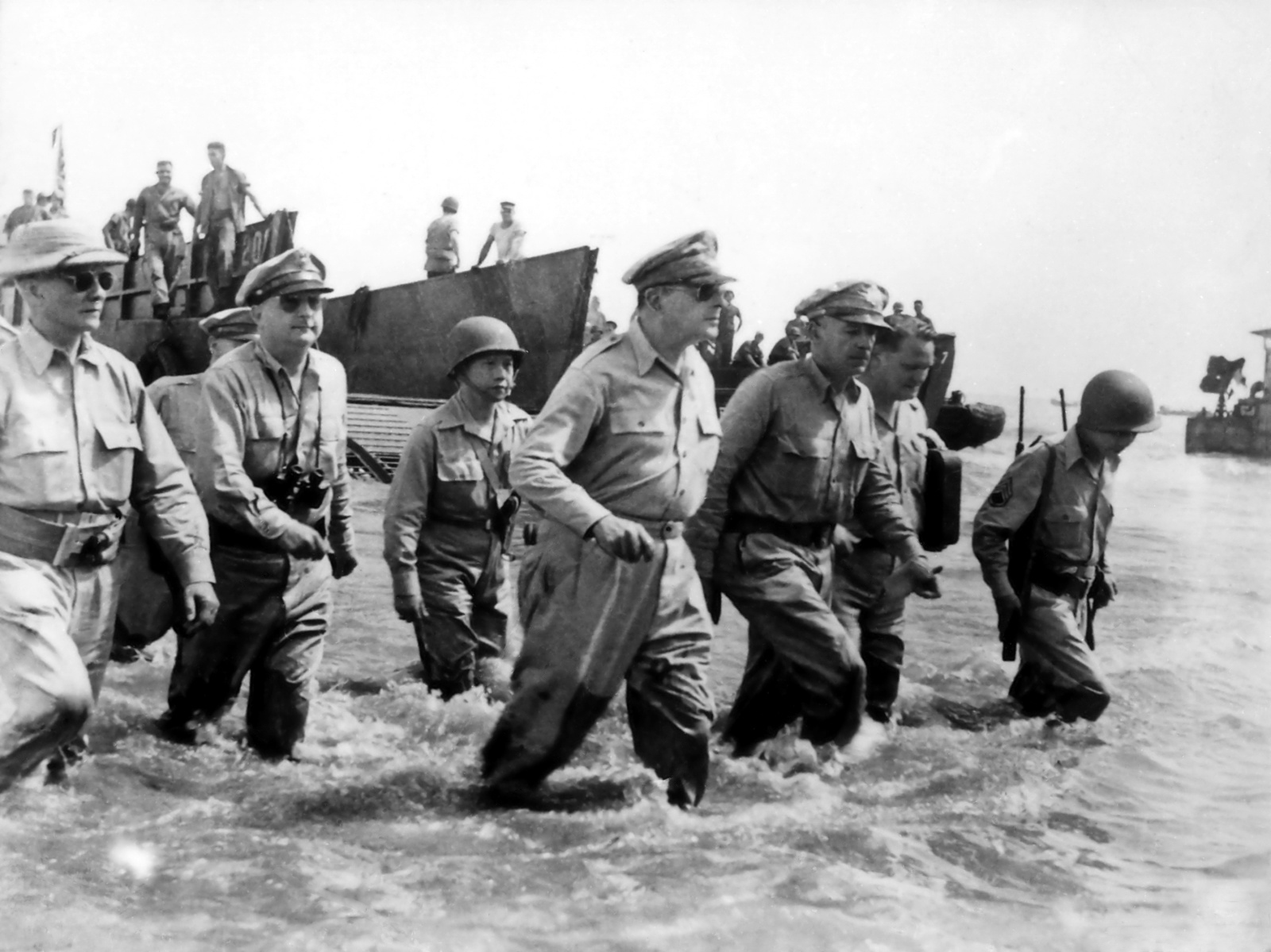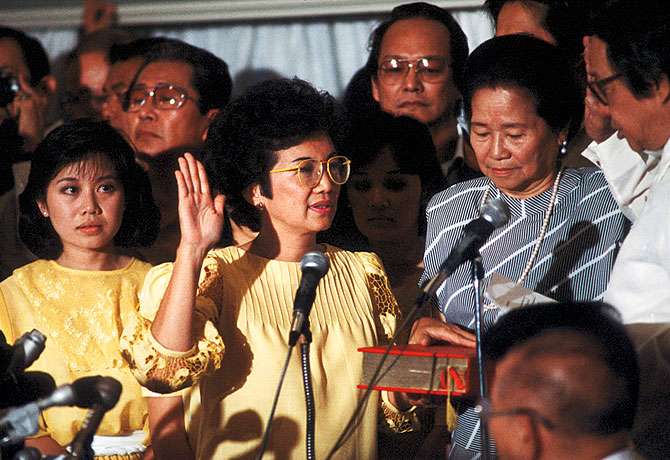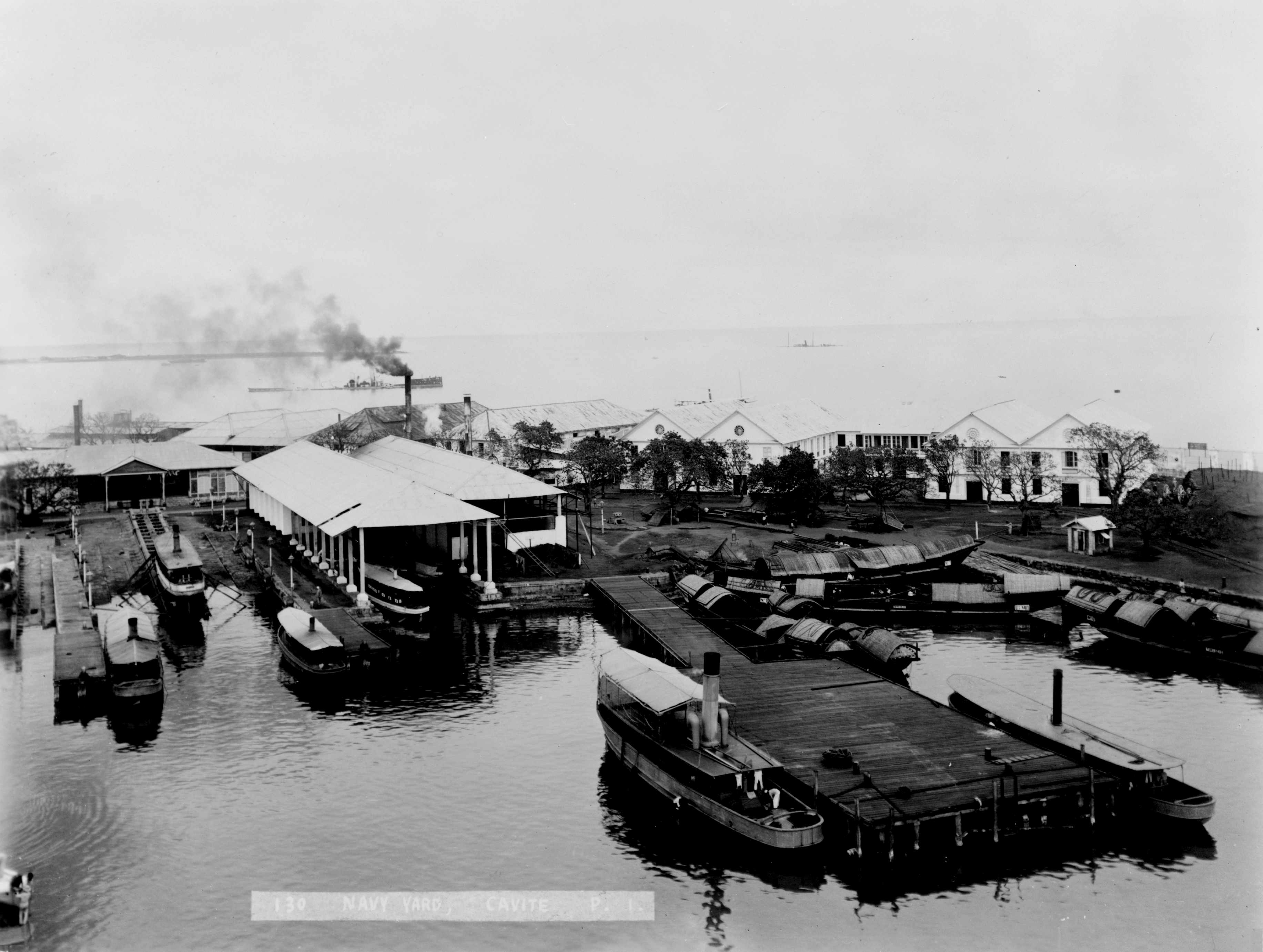|
US Bases In The Philippines
United States military bases were established in the Philippines on the basis of a treaty signed after the conclusion of World War II and the recognition of Philippine independence by the US. The bases established under that treaty were discontinued in 1991 and 1992, after the Senate of the Philippines narrowly rejected a new treaty which would have allowed some of the bases to continue for another ten years. This article summarizes the collective history of those bases. Establishment *On June 29, 1944, with WW-II still underway in both the European and Pacific theatres, a Joint Resolution of the US Congress authorized the President of the United States to acquire bases for the mutual protection of the Philippines. *On July 28, 1945, the Congress of the Philippines unanimously approved Joint Resolution No. 4, which authorized the President of the Philippines to enter into negotiations for the establishment of such bases. At that time, the Philippine islands were still occupied ... [...More Info...] [...Related Items...] OR: [Wikipedia] [Google] [Baidu] |
World War II
World War II or the Second World War (1 September 1939 – 2 September 1945) was a World war, global conflict between two coalitions: the Allies of World War II, Allies and the Axis powers. World War II by country, Nearly all of the world's countries participated, with many nations mobilising all resources in pursuit of total war. Tanks in World War II, Tanks and Air warfare of World War II, aircraft played major roles, enabling the strategic bombing of cities and delivery of the Atomic bombings of Hiroshima and Nagasaki, first and only nuclear weapons ever used in war. World War II is the List of wars by death toll, deadliest conflict in history, causing World War II casualties, the death of 70 to 85 million people, more than half of whom were civilians. Millions died in genocides, including the Holocaust, and by massacres, starvation, and disease. After the Allied victory, Allied-occupied Germany, Germany, Allied-occupied Austria, Austria, Occupation of Japan, Japan, a ... [...More Info...] [...Related Items...] OR: [Wikipedia] [Google] [Baidu] |
Naval Station Ernesto Ogbinar
Naval Station Ernesto Ogbinar, previously Naval Station Poro Point, is an installation of the Philippine Navy, located at Poro Point, in San Fernando, La Union, Philippines. It was previously a U.S. installation known as Wallace Air Station; transfer of ownership took place in 1991. The Poro Point installation occupied 101 hectares and was acquired in 1903 for the United States Cavalry. Originally, ''Camp Wallace'', the facility was named in honor of Second Lieutenant George W. Wallace, a Medal of Honor recipient from the U.S. 9th Infantry Regiment for actions on March 4, 1900, in the Philippines. In November 1903, President Theodore Roosevelt signed an executive order establishing Camp Wallace and Camp John Hay in Baguio. 848th Aircraft Control and Warning Squadron The land was later transferred to the United States Air Force and it was last home to the 848th Air Defense Squadron (ADS), which provided logistics and administrative support to other radar detachments. T ... [...More Info...] [...Related Items...] OR: [Wikipedia] [Google] [Baidu] |
Corazon Aquino
María Corazón "Cory" Sumulong Cojuangco-Aquino (; January 25, 1933 – August 1, 2009) was a Filipino politician who served as the 11th president of the Philippines and the first woman president in the country, from Presidency of Corazon Aquino, 1986 to 1992. She was the most prominent figure of the 1986 People Power Revolution, which ended the History of the Philippines (1965–1986), two-decade rule of President Ferdinand Marcos and led to the establishment of the current democratic History of the Philippines (1986–present), Fifth Philippine Republic. Aquino was married to Senate of the Philippines, Senator Benigno Aquino Jr., who was one of the most prominent critics of President Marcos. After the Assassination of Benigno Aquino Jr., assassination of her husband on August 21, 1983, she emerged as leader of the opposition against the president. In late 1985, Marcos called for a snap election, and Aquino ran for president with former Senator Salvador Laurel as her runni ... [...More Info...] [...Related Items...] OR: [Wikipedia] [Google] [Baidu] |
People Power Revolution
The People Power Revolution, also known as the EDSA Revolution or the February Revolution, were a series of popular Demonstration (people), demonstrations in the Philippines, mostly in Metro Manila, from February 22 to 25, 1986. There was a sustained campaign of civil resistance against regime violence and electoral fraud. The nonviolent revolution led to the departure of Ferdinand Marcos, the end of his 20-year dictatorship and the restoration of democracy in the Philippines. It is also referred to as the Yellow Revolution due to the presence of yellow ribbons during demonstrations (in reference to the Tony Orlando and Dawn song "Tie a Yellow Ribbon Round the Ole Oak Tree") as a symbol of protest following the Assassination of Benigno Aquino Jr., assassination of Filipino senator Benigno "Ninoy" Aquino Jr. in August 1983 upon his return to the Philippines from exile. It was widely seen as a victory of the people against two decades of presidential rule by President Marcos, ... [...More Info...] [...Related Items...] OR: [Wikipedia] [Google] [Baidu] |
Ferdinand Marcos 1969 Presidential Campaign
The 1969 reelection campaign of Ferdinand Marcos started in July 1969 when incumbent President Ferdinand Marcos was unanimously nominated as the Nacionalista's presidential candidate, and concluded when Marcos won an unprecedented second term. With Fernando Lopez as his running mate, he defeated the Liberal slate of Sergio Osmeña Jr. (son of former President Sergio Osmeña), and Genaro Magsaysay (younger brother of late President Ramon Magsaysay). During the campaign, Marcos launched US$50 million worth in infrastructure projects. Marcos was reported to have spent PHP100 for every PHP1 that his opponent Osmeña spent, including PHP24 million in Cebu alone. ''Time'' and ''Newsweek'' called the 1969 election the "dirtiest, most violent and most corrupt" in modern Philippine history. The term "Three Gs", meaning " guns, goons, and gold" was used to describe the administration's election tactics of vote-buying, terrorism and ballot snatching. Marcos' spending during the campaig ... [...More Info...] [...Related Items...] OR: [Wikipedia] [Google] [Baidu] |
Vietnam War
The Vietnam War (1 November 1955 – 30 April 1975) was an armed conflict in Vietnam, Laos, and Cambodia fought between North Vietnam (Democratic Republic of Vietnam) and South Vietnam (Republic of Vietnam) and their allies. North Vietnam was supported by the Soviet Union and China, while South Vietnam was supported by the United States and other anti-communist nations. The conflict was the second of the Indochina wars and a proxy war of the Cold War between the Soviet Union and US. The Vietnam War was one of the postcolonial wars of national liberation, a theater in the Cold War, and a civil war, with civil warfare a defining feature from the outset. Direct United States in the Vietnam War, US military involvement escalated from 1965 until its withdrawal in 1973. The fighting spilled into the Laotian Civil War, Laotian and Cambodian Civil Wars, which ended with all three countries becoming Communism, communist in 1975. After the defeat of the French Union in the First Indoc ... [...More Info...] [...Related Items...] OR: [Wikipedia] [Google] [Baidu] |
First Quarter Storm
The First Quarter Storm (), often shortened into the acronym FQS, was a period of civil unrest in the Philippines which took place during the "first quarter of the year 1970". It included a series of demonstrations, protests, and marches against the administration of President Ferdinand Marcos, mostly organized by students and supported by workers, peasants, and members of the urban poor, from January 26 to March 17, 1970. Protesters at these events raised issues related to social problems, authoritarianism, alleged election fraud, and corruption at the hand of Marcos. Violent dispersals of various FQS protests were among the first watershed events in which large numbers of Filipino students of the 1970s were radicalized against the Marcos administration. Due to these dispersals, many students who had previously held "moderate" positions (i.e., calling for legislative reforms) became convinced that they had no choice but to call for more radical social change. Similar watersh ... [...More Info...] [...Related Items...] OR: [Wikipedia] [Google] [Baidu] |
Filipino Nationalism
Filipino nationalism refers to the establishment and support of a political identity associated with the modern nation-state of the Philippines, leading to a wide-ranging campaign for political, social, and economic freedom in the Philippines. This gradually emerged from various political and armed movements throughout most of the Spanish East Indies—but which has long been fragmented and inconsistent with contemporary definitions of such nationalism—as a consequence of more than three centuries of Spanish rule. These movements are characterized by the upsurge of anti-colonialist sentiments and ideals which peaked in the late 19th century led mostly by the ilustrado or landed, educated elites, whether ''peninsulares'', '' insulares'', or native (''Indio''). This served as the backbone of the first nationalist revolution in Asia, the Philippine Revolution of 1896. The modern concept would later be fully actualized upon the inception of a Philippine state with its contemporary ... [...More Info...] [...Related Items...] OR: [Wikipedia] [Google] [Baidu] |
Baguio
Baguio ( , , ), officially the City of Baguio (; ; ), is a Cities of the Philippines#Legal classification, highly urbanized city in the Cordillera Administrative Region, Philippines. It is known as the "Summer Capital of the Philippines", owing to its cool climate since the city is located approximately above mean sea level, often cited as in the Luzon tropical pine forests ecoregion, which also makes it conducive for the growth of mossy plants, orchids and pine trees, to which it attributes its other moniker as the "City of Pines". Baguio was established as a hill station by the United States in 1900 at the site of an Ibaloi people, Ibaloi village known as ''Kafagway''. It was the United States' only hill station in Asia. Baguio is classified as a Cities of the Philippines#Classification, highly urbanized city (HUC). It is the largest city in Benguet, serving as the provincial capital from 1901 to 1916, but has since been administered independently from the province fol ... [...More Info...] [...Related Items...] OR: [Wikipedia] [Google] [Baidu] |
Zambales
Zambales, officially the Province of Zambales (; ; ; ; ), is a Provinces of the Philippines, province in the Philippines located in the Central Luzon Regions of the Philippines, region. Its capital is Iba, Zambales, Iba, which is located in the middle of the province. Olongapo is the largest city of the province wherein it is geographically located but politically independent. Zambales borders Pangasinan to the north and northeast, Tarlac to the east, Pampanga to the southeast, Bataan to the south and the South China Sea to the west. With a total land area of (including the independent city of Olongapo), Zambales is the second largest among the seven provinces of Central Luzon after Nueva Ecija. The province is noted for its mangoes, which are abundant from January to April. Zambales does not have a functional airport; the closest functional airport is Clark International Airport in Angeles City in the neighbouring province of Pampanga. Subic Bay International Airport, which ... [...More Info...] [...Related Items...] OR: [Wikipedia] [Google] [Baidu] |
Cavite
Cavite, officially the Province of Cavite (; Chavacano: ''Provincia de Cavite''), is a Provinces of the Philippines, province of the Philippines located in the Calabarzon region. On the southern shores of Manila Bay and southwest of Manila, it is one of the most industrialized and fastest-growing provinces in the Philippines. As of 2020, Cavite is one of the List of Philippine provinces by population, largest province in the country in terms of population, which had 4,344,829 people if the Cities of the Philippines, independent cities of Cebu are excluded from Cebu's population figure. The ''de facto'' capital and seat of the government of the province is Trece Martires, although Imus is the official (''de jure'') capital while the Dasmariñas, City of Dasmariñas is the largest city in the province. For over 300 years, the province played an important role in both the country's colonial past and eventual fight for independence, earning it the title "Historical Capital of the ... [...More Info...] [...Related Items...] OR: [Wikipedia] [Google] [Baidu] |
Sangley Point
Naval Station Sangley Point was a communication and hospital facility of the United States Navy which occupied the northern portion of the Cavite City peninsula and is surrounded by Manila Bay, approximately eight miles southwest of Manila, the Philippines. The station was a part of the Cavite Navy Yard across the peninsula. The naval station had a runway that was built after World War II, which was used by U.S. Navy Lockheed P-2 Neptune, Lockheed P-3 Orion, and Martin P4M Mercator maritime patrol and anti-submarine warfare aircraft. An adjacent seaplane runway, ramp area and seaplane tender berths also supported Martin P5M Marlin maritime patrol aircraft until that type's retirement from active naval service in the late 1960s. NAS Sangley Point/NAVSTA Sangley Point was also used extensively during the Vietnam War, primarily for U.S. Navy patrol squadrons forward deployed from the United States on six-month rotations. The naval station was turned over to the Philippine gove ... [...More Info...] [...Related Items...] OR: [Wikipedia] [Google] [Baidu] |







